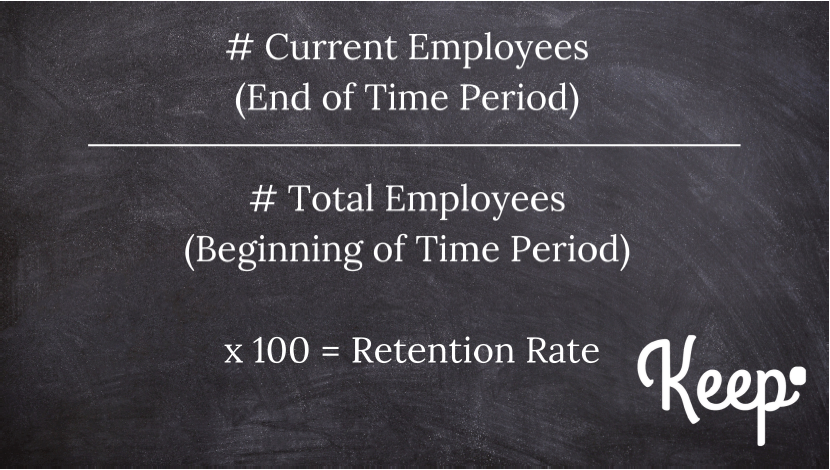-
Why Keep?
Why Keep
-
Employers
-
Employees
-
- Solutions
- Resources
- About Us
How to Calculate Employee Retention: A Comprehensive Guide
How to Calculate Employee Retention: A Comprehensive Guide
Employee retention is an essential factor in any organization's success. It involves measuring the length of time employees remain at a company and why they choose to stay - or leave - their job roles. But, calculating employee retention can be complex, with a myriad of factors to consider when evaluating each employee's experience. Fortunately, with the right knowledge and guidance from experts, you can maximize employee retention within your organization--and that's what this guide hopes to provide!
This comprehensive guide will offer insight into how to calculate and better understand your team’s employee retention numbers for improved organizational performance in the long term. So if you’re ready to learn more about improving workplace commitment among staff members - keep reading!
What is a Good Employee Retention Rate?
A good employee retention rate is critical in today's competitive job market. Simply put, it is the percentage of employees who remain with a company over a given time frame. While the ideal retention rate can vary among industries, most consider a rate of 90% or higher to be good.
However, employers should also consider factors such as workforce demographics and company culture when measuring retention rates. In general, a low retention rate can lead to higher costs for recruitment and training, decreased productivity, and a negative impact on company culture. Therefore, companies need to focus on retaining their top talent to maintain a healthy and thriving workforce.
How to Calculate Employee Retention
Employee retention is crucial to the success of any organization. It helps to stabilize the workforce, reduce recruitment costs, and maintain a positive work environment. Calculating employee retention is easy, and can be done by dividing the number of employees who stayed with the company during a specified period by the total number of employees at the beginning of that period.
# Current Employees (End of Time Period) / # Total Employees (Beginning of Time Period) x 100 = Retention Rate

This percentage represents your employee retention rate for that time frame. Keeping track of employee retention is an essential part of HR management and should be monitored regularly. By doing so, organizations can identify trends and address any issues that may be contributing to high turnover rates. Taking steps to improve employee retention can lead to a more loyal and productive workforce, which can ultimately benefit the company's bottom line.
What is Retention vs Turnover Rate?
Simply put, employee turnover is the proportion of your workforce who leave during a period (usually per year). Retention is the proportion of employees who stay.
Retention and turnover rates are two crucial metrics used to measure the employee stability of an organization. Retention refers to the number of employees who continue to work for a company over a specific period, while turnover rate measures the number of employees who leave the organization voluntarily or involuntarily during the same period.
A high employee retention rate signifies that the organization values its employees and ensures they are satisfied with their roles, whereas a high turnover rate may point towards issues such as low employee engagement, low compensation, or unsatisfactory job roles. Therefore, it is essential for organizations to closely monitor both metrics to ensure the success of the business and maintain employee satisfaction.
Retention Rates by Industry
Retention rates vary across different industries, with some sectors experiencing higher turnover rates than others. For example, the hospitality industry is notorious for having a high turnover rate due to the seasonal nature of the work and the long and often unsociable working hours. In contrast, the technology industry tends to have a lower turnover rate as it offers employees a different set of benefits, such as opportunities for career growth and development.
Understanding the retention rates by industry is crucial for businesses looking to attract and retain the best talent. By identifying the factors that influence retention rates in different sectors, employers can develop strategies to keep their employees engaged, motivated, and committed to the success of the organization.
Industry
Administrative Services
Advertising
Agriculture and Farming
Apps
Artificial Intelligence
Biotechnology
Clothing and Apparel
Commerce and Shopping
Community and Lifestyle
Consumer Electronics
Consumer Goods
Content and Publishing
Data and Analytics
Design
Education
Energy
Events
Financial Services
Food and Beverage
Gaming
Government and Military
Hardware
Health Care
Information Technology
Internet Services
Lending and Investments
Manufacturing
Media and Entertainment
Messaging and Telecommunications
Mobile
Music and Audio
Natural Resources
Navigation and Mapping
Oil and Gas
Other
Payments
Platforms
Privacy and Security
Professional Services
Real Estate
Sales and Marketing
Science and Engineering
Software
Sports
Sustainability
Transportation
Travel and Tourism
Video
Retention Rates (2022)
92.67%
92.34%
89.80%
90.64%
83.10%
90.58%
93.53%
90.54%
92.45%
92.92%
92.31%
93.28%
85.33%
93.26%
91.66%
90.75%
93.23%
86.97%
88.66%
88.20%
93.53%
91.61%
86.93%
89.61%
91.11%
92.81%
93.70%
90.04%
89.70%
89.98%
92.07%
94.57%
92.36%
90.82%
92.92%
87.34%
90.64%
89.32%
92.70%
90.73%
87.46%
91.13%
84.65%
91.14%
91.52%
90.56%
92.14%
89.97%
Turnover Rates (2022)
7.33%
7.66%
10.20%
9.36%
16.90%
9.42%
6.47%
9.46%
7.55%
7.08%
7.69%
6.72%
14.67%
6.74%
8.34%
9.25%
6.77%
13.03%
11.34%
11.80%
6.47%
8.39%
13.07%
10.39%
8.89%
7.19%
6.30%
9.96%
10.30%
10.02%
7.93%
5.43%
7.64%
9.18%
7.08%
12.66%
9.36%
10.68%
7.30%
9.27%
12.54%
8.87%
15.35%
8.86%
8.48%
9.44%
7.86%
10.03%
Conclusion
Employee retention is the keystone to any thriving business. Companies must understand that employee retention is multifaceted – from competitive pay and good benefits to a supportive and friendly culture; numerous elements play into an employee's overall satisfaction.
It's essential to not only calculate your employee turnover rate, but also figure out where improvements can be made – so no employees feel neglected, or taken advantage of due to poor industry standards. By diligently doing this calculation, you'll ensure success in retaining quality employees.
If you'd like to learn more about improving, measuring, and understanding employee retention, Keep Financial has created an ultimate guide just for you. Check it out and see what kind of helpful insights you can gain!
Learn more with the Ultimate Guide to Employee Retention & Strategies here.
Keep Financial offers a vesting cash bonus that can help incentivize employees to find a shared purpose and commitment to the organization that helps keep top talent on board.
To learn how Keep Financial can help you deliver valuable, flexible compensation that fits the needs of today’s workforce, schedule a demo today!



